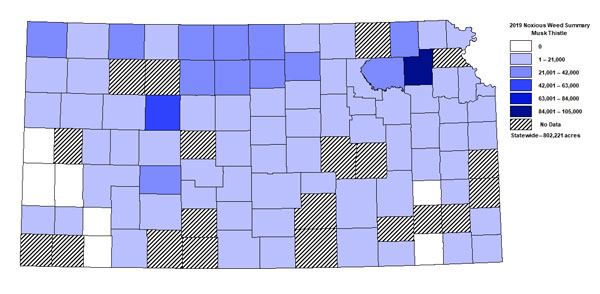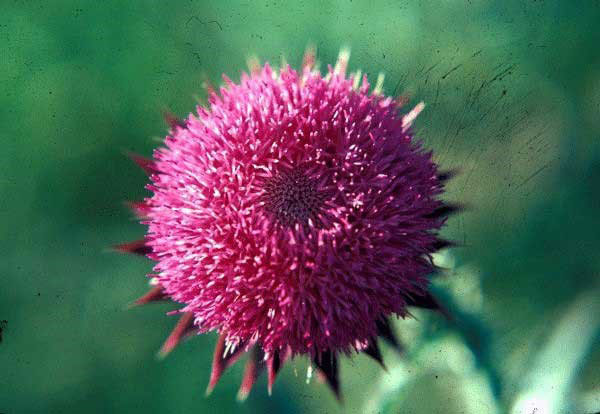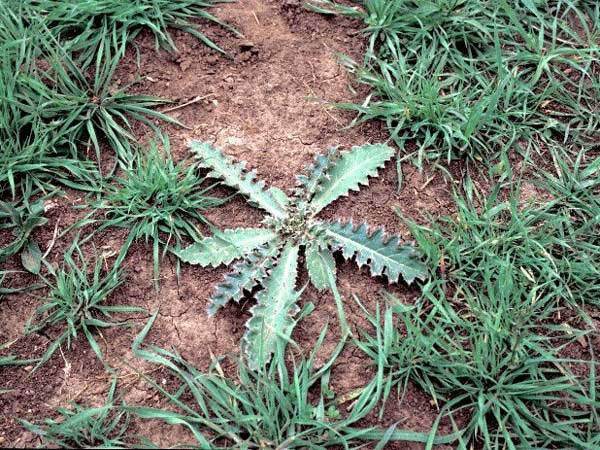Musk thistle (Carduus nutans) is one of 12 state-wide noxious weeds in Kansas infesting over 700,000 acres. Musk thistle has been reported in nearly every county in Kansas (Figure 1) and is found primarily in pastures, rangeland, hay meadows, alfalfa, fallow, roadsides, and waste areas.

Figure 1. Distribution of musk thistle in Kansas. Map courtesy of the Kansas Department of Agriculture.
Musk thistle is primarily a biennial or winter annual species. Biennials take two growing seasons to complete their life cycle. Thistles that germinate in the spring will spend the entire summer as a rosette, live through the winter, and bolt the next year in May and June. Winter annual plants will germinate with moisture and warm temperatures in the fall, live through the winter, and bolt the following year.
Most people recognize musk thistle during the early summer when the plants are actively blooming (Figure 2, top photo). However, musk thistle control is easiest as a rosette (Figure 2, bottom photo).


Figure 2. Musk thistle in flowering and rosette stages of growth. Photo courtesy of Walt Fick, K-State Research and Extension.
Fall is an excellent time to spray musk thistle as all are in the rosette stage of growth. Another advantage for treatment in the fall is reduced risk of off-target drift. Waiting until most deciduous trees have lost their leaves and most crops are harvested will greatly reduce the likelihood of damage from herbicide drift. A wider window of opportunity for treating musk thistle also exists in the fall. The spraying window in the fall probably extends until the ground is frozen and the musk thistle plants have shut down activity until warmer temperatures in the spring. Freezing temperatures will start to damage musk thistle plants, with some yellowing and curling of leaves. However, the plants are susceptible to herbicides as long as green tissue exists.
Dry conditions in the fall can reduce control of musk thistle with certain herbicides, but studies in Kansas indicated that a fall application of 2,4-D LVE at 2 lbs per acre was more effective (80% control) than a similar rate of 2,4-D amine (49% control). Dicamba + 2,4-D amine at 0.25 + 0.75 lbs per acre and picloram at 0.125 lbs per acre were also effective (>90% control) on musk thistle treated in the fall.
Data presented in Table 1 were collected in July 2013 following treatment on December 6, 2012. Conditions at the time of treatment were 50 degrees F air temperature, 66% relative humidity, and 6-8 mph wind speed. Skies were overcast and cloudy. All treatments provided excellent control of rosettes present at the time of spraying (data not shown).
The data in this table reflect residual control of rosettes that germinated during spring 2013. The number of rosettes on untreated plots increased 92% between December 2012 and July 2013, indicating spring germination. The only treatment not providing nearly 100% residual control was 2,4-D LVE applied at 64 fl oz per acre. The active ingredient in Milestone is aminopyralid. Tordon 22K contains 2 lbs per gallon picloram. Chaparral contains aminopyralid and metsulfuron. These products are all labelled for use on range and pasture. Milestone, 2,4-D, and Tordon 22K are also labeled for use on non-cropland sites including roadsides, right-of-ways, and industrial sites. Opensight was not included in this test, but is a product similar to Chaparral that can be used on non-cropland sites.
Table 1. Musk thistle control with herbicides applied on December 6, 2012.
|
Herbicide |
Rate |
% control, |
|
Milestone |
3 fl oz |
99 |
|
Milestone |
4 fl oz |
100 |
|
Milestone |
5 fl oz |
100 |
|
Tordon 22K |
10 fl oz |
100 |
|
2,4-D LVE |
64 fl oz |
43 |
|
Chaparral |
1.5 oz |
100 |
|
Untreated |
--- |
0 |
If you need to treat musk thistle this fall, herbicides exist that will not only control the rosettes at the time of application, but will carryover and control new emerging rosettes next spring. If possible, select a warm, sunny day when spraying musk thistle this fall.
Walt Fick, Rangeland Management Specialist
whfick@ksu.edu
Tags: musk thistle noxious weed